A historical background of Albania
The Lord has proven over and over again His heart and love for the people and the nation of Albania throughout millennia. In fact, only a handful of nations are privileged enough to find themselves mentioned in the pages of the New Testament, and we are humbled to be among those nations. In the book of Romans, the Apostle Paul writes:
“Through mighty signs and wonders, by the power of the Spirit of God; so that from Jerusalem, and round about unto Illyricum, I have fully preached the gospel of Christ.” Romans 15:19
Illyricum is the ancient name of the territories of present day Albania, Kosovo and other lands in the region still inhabited by ethnic Albanians today.1
There is good reason why Paul mentions Illyricum to the Romans. As indicated by the map, Illyricum was located right across Italy on the other shore of the Adriatic Sea, the closest point being the Otranto strait, about 50 miles from Italy. When Paul stood on the Albanian shore this was the closest he ever got to the Roman believers before getting there.
 (map of the ancient world: Illyricum, Epirus, Thessaly, Roman Empire)
(map of the ancient world: Illyricum, Epirus, Thessaly, Roman Empire)
Paul made his visit in at least two or three Illyrian cities. The most famous of them is Dyrrachicum, present day Durres. The ruins of that great ancient city, its marketplace, its colosseum-style stadium and many other historical sites are commonly found throughout the city to this day.
Dyrrachicum was an old Illyrian city, established by Greek Corinthian colonists and the Taulanti Illyrian tribe 7th century B.C. under the name of Epidamnos, among the richest cities in the Ancient Greek world2.
Later known as Dyrrachicum, the city essentially developed as it became an integral part of the Roman Empire, and its successor the Byzantine Empire. It was an important port city which hosted Illyrian, Greek and a thriving Jewish community. It was great in power and very populated. Under Roman rule, Dyrrachium prospered; it became the western end of the Via Egnatia.
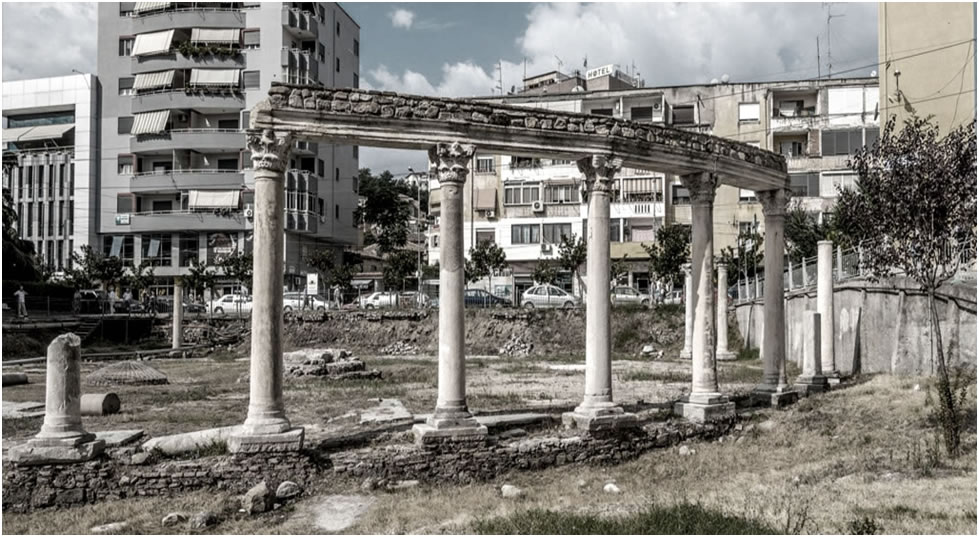 (Dyrrachicum market place, present day Durres)
(Dyrrachicum market place, present day Durres)
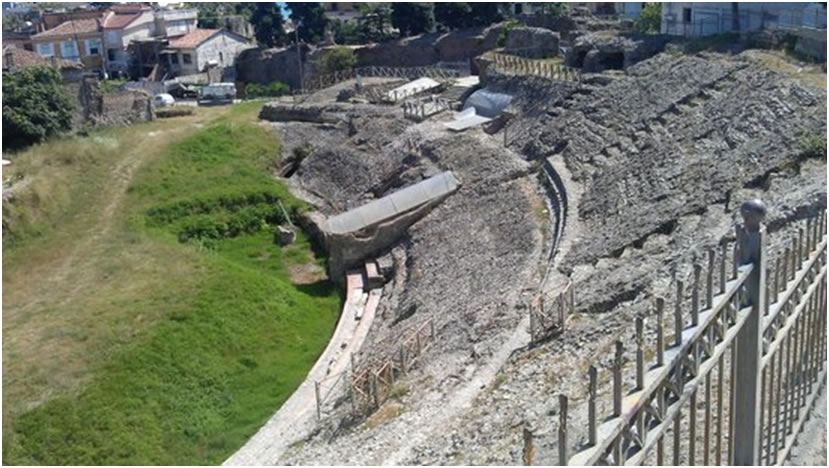 (Dyrrachicum Roman amphitheatre, built in 2nd century A.D., largest in the Balkans, 20,000 capacity)
(Dyrrachicum Roman amphitheatre, built in 2nd century A.D., largest in the Balkans, 20,000 capacity)
Dyrrachicum port was the starting point of The Via Egnatia, an important road constructed by the Romans in the 2nd century BC. Stretching for 1,120 km, it crossed Illyricum, Macedonia, and Thracia, running through territories that are now part of modern day Albania, North Macedonia, Greece, and European Turkey, (running through Thessalonica all the way to Constantinople), as a continuation of the Via Appia. Basically, the highway went from Rome to Constantinople3.
In the years 53-56 A.D. Paul spent a winter in Nicopolis (Titus 3:12) which is in Southern Illyricum. It is believed that the first bishop of the church of Dyrrachicum, Ceasar of Apollonia was ordained during this missionary trip. Durrës became a Christian city quite early on; its first congregation is mentioned by various sources as created around the year 58, listing a membership of 70 Christian families4.
To put it in perspective, Paul wrote the letter to the Romans in the winter of 57-58 AD, while he was in the Greek city of Corinth.
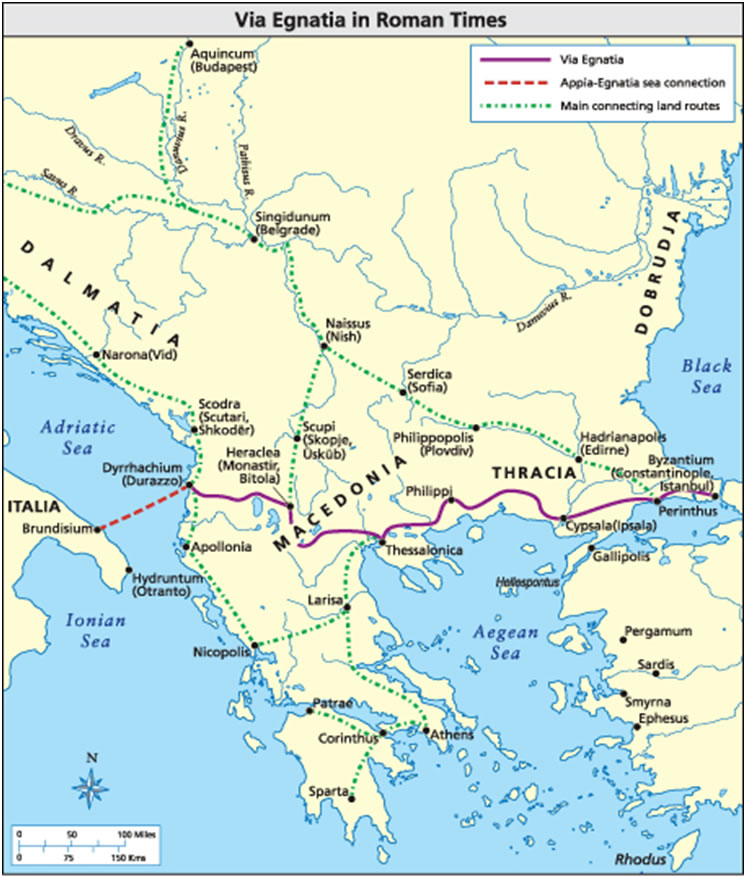 (map of Via Egnatia, connecting through the Adriatic with Via Appia, from Rome to Constantinople)
(map of Via Egnatia, connecting through the Adriatic with Via Appia, from Rome to Constantinople)
During the reign of the Catholic Roman Empire, Illyricum was often the borderline and clashing point of influence between the Western and the Eastern Church rule. The majority of the Southern Albanian territories, and were primarily under the Byzantine rule, while the Northern territories opted for the Latin Church rule. The Albanian territories, however, were strongly favored by emperor Justinian, as he was of Albanian descent. A handful of the oldest Byzantine churches in the region that survive to this day were built by Justinian’s patronage. It is important to note that the early Albanian churches had a vast wealth of biblical text, over 100 manuscripts or codices of various contents surviving to this day.
Manuscripts in Albania The most famous of the codex manuscripts found in Albania to this day is codex Purpureus Beratinus (the purple codex of Berat), a 6th century manuscript. Originally it contained all 4 gospels, of which today only Mathew and Mark survive. A later note in the manuscript states the loss of the other two gospels due to “the Franks of Champagne”, most likely crusaders who invaded the castle of Berat.
 (an exhibit of various biblical texts from Berat, Albania)
(an exhibit of various biblical texts from Berat, Albania)
It is a unical illuminated manuscript in Greek, containing 190 parchment leaves, with two text columns per page, 17 lines per page, 8-12 letters per line, in silver ink. The text is divided in chapters but not in verses. According to the archbishop of Berat, Anthime Alexoudis, on one side of the manuscript’s cover it states: “Look upon the letters of this gospel, written by the hand of Saint John Chrysostom, when he was a preacher of the gospel in his fatherland, Antioch”.
 (Codex Purpureus Beratinus)
(Codex Purpureus Beratinus)
 (Gravure of John Chrysostom, bishop of Antioch, Archbishop of Constantinople)
(Gravure of John Chrysostom, bishop of Antioch, Archbishop of Constantinople)
Albania under Ottoman Rule Throughout the centuries Albania was inhabited by Latins, Greeks and Jews until the middle ages, when Albanian territories fell under the Islamic invasion. Regardless of the quarter century resistance led by Gjergj Kastrioti, the medieval Albanian ruler, after his death the region succumbed to the Ottoman Empire. The Ottoman rule was brutal, destroying to the ground and burning entire cities and communities, burning institutions of learning and any historical indications of the pre-existing populations, destroying churches and erecting mosques right on top of them, forcing conversion of the population to Islam by violence, death, and higher taxes.
 (The helmet of Gjergj Kastrioti - Skanderbeg, Albanian nobleman who led resistance against the Ottoman Empire. The bottom bares a copper strip adorned with monograms separated by rosettes. The inscription is rendered as: “Jesus Nazarene bless thee, [Skanderbeg], Prince of Emathia, King of Albania, Terror of the Ottomans, King of Epirus” – source: Kunthistorisches Museum, Vienna)
(The helmet of Gjergj Kastrioti - Skanderbeg, Albanian nobleman who led resistance against the Ottoman Empire. The bottom bares a copper strip adorned with monograms separated by rosettes. The inscription is rendered as: “Jesus Nazarene bless thee, [Skanderbeg], Prince of Emathia, King of Albania, Terror of the Ottomans, King of Epirus” – source: Kunthistorisches Museum, Vienna)
Many Albanian Christians facing this persecution fled across the Adriatic to Italian territories. The Albanian phase of the Byzantine tradition in southern Italy began when the Ottoman Turks moved through the Balkans in the 14th and 15th centuries and wiped out the Albanian, Bulgarian, Romanian and Serbian states. The Albanian resistance collapsed after the death of Gjergj Kastrioti Skanderbeg, the chief of the Albanian insurgency. Rather than serve the Ottoman sultan, thousands of Albanian refugees poured into such diverse Italian regions as Abruzzi and Molise, Basilicata, Calabria, Puglia and Sicily. Those Albanians from the northern portion of the country – primarily Latin Catholics – were quickly absorbed into Italian culture.
Southern Albanians were Byzantine Christians who maintained ties to the Church of Constantinople, which was reduced to a subordinate condition following the collapse of Constantinople in 1453. The arrival of the first Albanian immigrants to Italy is in 1448. Between 1448 and 1532 several waves of Albanian immigrants settled in the Puglia region, in Calabria, and in Sicily. The last wave of immigration to Abruzzi in southern Italy is reported to have occurred in 1774. These Albanians, numbering in the tens of thousands, crossed the Adriatic and Ionian seas to evade persecution by the Turkish invaders of their homeland. And they took with them their manuscripts and set up their distinct Byzantine churches in Italy.
It is important to have the Albanian migration in context to the bigger picture of manuscript history. In their flight, the refugees from all over the Byzantine Empire brought with them Greek manuscripts of the Bible as well as writings of early church fathers and ancient classical writers. Latin had been the scholarly language of Europe for a millennium. The sudden availability of numerous Greek manuscripts encouraged the Renaissance humanists to go back to the sources of Greek manuscripts. Perhaps the most definitive work based on these sources was that of Desiderius Erasmus of Rotterdam (1466-1536), who spent three years in Italy, nine months of which in Venice, which boasted a community of 5000 Greek-speaking refugees.
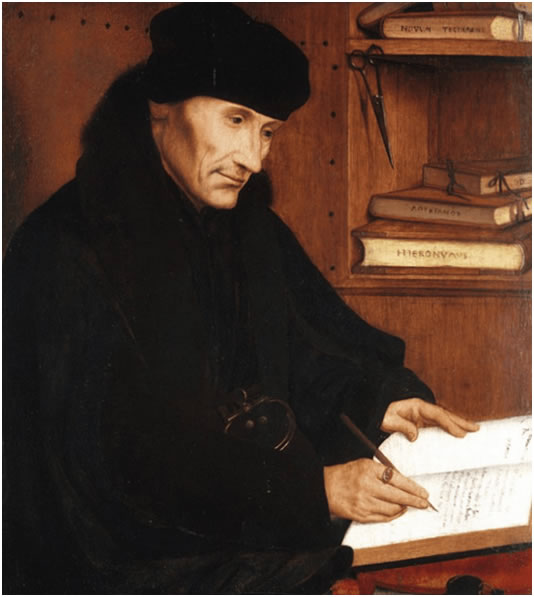 A 1517 CE portrait by Quentin Matsys of the Netherlandish Renaissance scholar Desiderius Erasmus (Nationalgalerie Antiker Kunst, Rom, Germany)
A 1517 CE portrait by Quentin Matsys of the Netherlandish Renaissance scholar Desiderius Erasmus (Nationalgalerie Antiker Kunst, Rom, Germany)
Will Durant, noted historian and philosopher wrote: While Erasmus was in Italy he spent all of his time "devouring the libraries". "Comparing two codices...for the more correct reading of some intricate passage" was his passion5. When he went to Basel to work on the printing of this Greek New Testament, he arrived “weighed down with books...and copious notes on the New Testament”6
 (map of Albania in 1824, reflecting the devastation and lack of progress as result of Islamic rule. Photo appears in “The Albanian Book and Protestant Enterprise: a 200 year cultural journey”. (2017) Used by permission of the Institute for Albanian and Protestant Studies)
(map of Albania in 1824, reflecting the devastation and lack of progress as result of Islamic rule. Photo appears in “The Albanian Book and Protestant Enterprise: a 200 year cultural journey”. (2017) Used by permission of the Institute for Albanian and Protestant Studies)
The consequences of 5 centuries of Ottoman-Islamic rule in Albania were devastating and echo to this day. During 500 years of occupation the sultans’ rule forbade the writing, teaching and speaking of the native language, maintaining power through ignorance, violence and superstition. Once a jewel on the Mediterranean, the Albanian territories were reduced to a speck of their previous glory. Although the population would erupt in continuous uprisings and armed rebellions, none were successful enough to gain full freedom from the tyrannical rule. The country had become a wild wasteland, with limited communications among its various regions, and a dark land in need for the light of the gospel. But God, rich in mercy and grace did not forget the souls of Albanians.
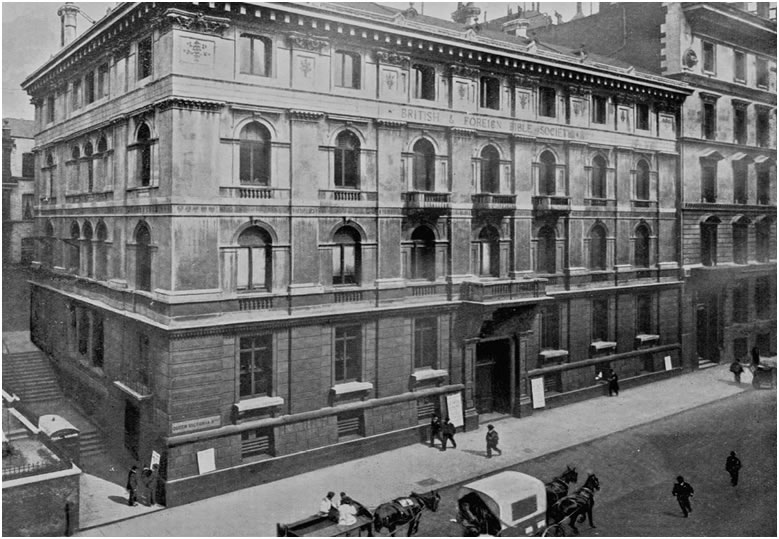 The British Bible Society headquarters, founded in 1804. Photo appears in “The Albanian Book and Protestant Enterprise: a 200 year cultural journey”. (2017)
The British Bible Society headquarters, founded in 1804. Photo appears in “The Albanian Book and Protestant Enterprise: a 200 year cultural journey”. (2017)
The British and Foreign Bible Society was founded in 1804, with a simple but profound vision “The Bible for the World”. Amazingly the Albanian language attracted their attention as early as 1816, “decades prior to the beginnings of the Albanian National Awakening”.
In August 26, 1816 a letter from the missionary Robert Pinkerton published in the British and Foreign Bible society report for 1817 states: “The furnishing of the Albanians with a New Testament in their own language is an object highly worthy of the attention of the British Bible Society. This nation occupies a great part of the ancient Illyricum and Epirus, and speaks a language with no grammatical affinity with the Slavs, Turkish, or Latin languages. I have no doubt, from the conversations I have had with some intelligent Albanians here, that persons, competent to the task, are to be found there, and the expense, both of translation and printing, must be defrayed by the British and Foreign Bible Society”.7
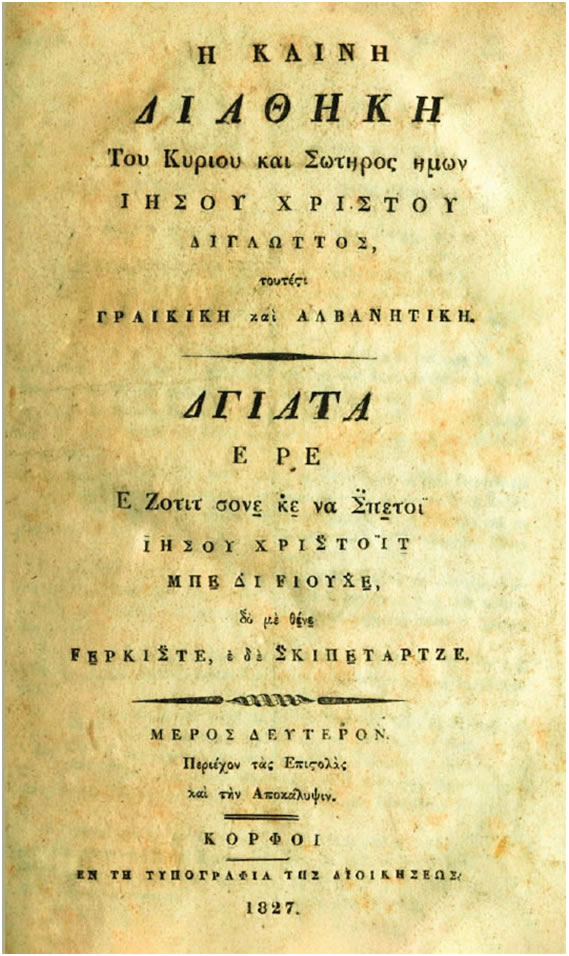 Inner leaf of the New Testament printed with Greek alphabet, 1827, from the Textus Receptus line of manuscripts. Photo appears in “The Albanian Book and Protestant Enterprise: a 200 year cultural journey”. (2017)
Inner leaf of the New Testament printed with Greek alphabet, 1827, from the Textus Receptus line of manuscripts. Photo appears in “The Albanian Book and Protestant Enterprise: a 200 year cultural journey”. (2017)
The first book of the Bible ever translated and printed in Albanian is gospel of Mathew in 1824. It is also the first ever printed book in the Albanian language. It was a test-run in preparation for the printing of the New Testament. Thanks to the persistence of Robert Pinkerton, the British Bible Society signed a translation agreement with Vangjel Meksi, an educated Albanian doctor. He completed his translation in 1821, but the challenge was immense, given the fact that for 500 years the use of the language had been forbidden by the Turks, thus there was no formal Albanian alphabet. This first book is printed in Albanian but with Greek letters, and with an introductory page explaining the letters they used. In 1827 the Albanian New Testaments was published for the first time, containing 486 pages, 2000 copies, made possible by the British Bible Society.8
The British and Foreign Bible society faced a multitude of difficulties as they worked to distribute Albanian Bibles between the years 1816-1858. Among many obstacles they recognized the need for a capable Albanian translator as well as for a qualified and determined missionary to push forward the Albanian project. In 1860 they found Alexander Thomson, who developed a productive and enduring working relationship with Kostandin Kristoforidhi.
 (portrait of Konstandin Kristoforidhi, patriot, teacher, and Albanian Bible translator from the Hebrew and Greek languages, from the Textus Receptus line of manuscripts)
(portrait of Konstandin Kristoforidhi, patriot, teacher, and Albanian Bible translator from the Hebrew and Greek languages, from the Textus Receptus line of manuscripts)
Konstandin Kristoforidhi was born the same year as the first publishing of the New Testament in Albanian, in 1827. As a bright young man dedicated to learning, he studied in the Greek college of Zosimea in the 1850s. In 1857 his life would change forever when he met while in Smyrna (Izmir), Turkey, the American evangelical missionary, David Ladd. Later Kristoforidhi joined the Protestant Christian church in that city, and that provided the connection between hims and the Bible Society, which shaped his life’s calling and work.
The American missionary gave this testimony in a recommendation letter about Kristoforidhi:
“Three new members have just been admitted. One of these is a liberally-educated Albanian. He was brought up on the shores of the Adriatic. At sixteen he went to the university of Athens, where he spent six years, after which he was ten years in government employment in Trieste, whence he came nine months ago. He was of the Greek faith, but, while in Athens, he became an infidel, and so remained during his academical course. While at Trieste, however, his conscience did not let him rest. He began to read Greek theological writers, to find some reason for their faith, but could not. He then turned to Roman-Catholic writers, but found them still more unsatisfactory. At length, after years of melancholy, he found Protestant books, and, reading them, began to hope that he had secured food for his soul. When he came to Smyrna he was already well satisfied as to the authority and the revelation of the Protestant faith. This was before seeing a missionary or conversing with an evangelical Christian. He soon came to see the reverend Mr. Ladd, had many conversations with him, began to attend our service, and after several months, desired to be admitted to the church. After a full examination, he was received. For several months he has expressed a strong desire to accompany any missionaries to his own country, although he is now profitably employed in the Austrian Consulate of this city. These missionary longings have lately taken the definite form of a desire to translate the Scriptures for the Albanians. He is peculiarly adapted for this work, having a good university education, by which a naturally strong mind has been trained: the addition of a theological course has been deemed desirable, and he has been sent to Constantinople, to pursue his studies, and to carry out his translation”.9
In Istanbul Kristoforidhi studied at the Bebek Theological Seminary, and then on to the Protestant College of Malta for three years. In 1865 the British Bible Society through its missionary to Istanbul, Alexander Thomson, called on Kristoforidhi to translate the New Testament in the Gheg Albanian dialect. In preparation for the bible publication, Kristoforidhi also worked on the creation of a latin-based Albanian alphabet, earning the name of “the father of the Albanian language”. The result of this partnership between Thomson and Kristoforidhi were several publications of the New Testament in the two major Albanian dialects, the Psalms, the Gospels, a History of the Scriptures, a variety of scholastic books and a continuous work for the development of the Albanian alphabet.
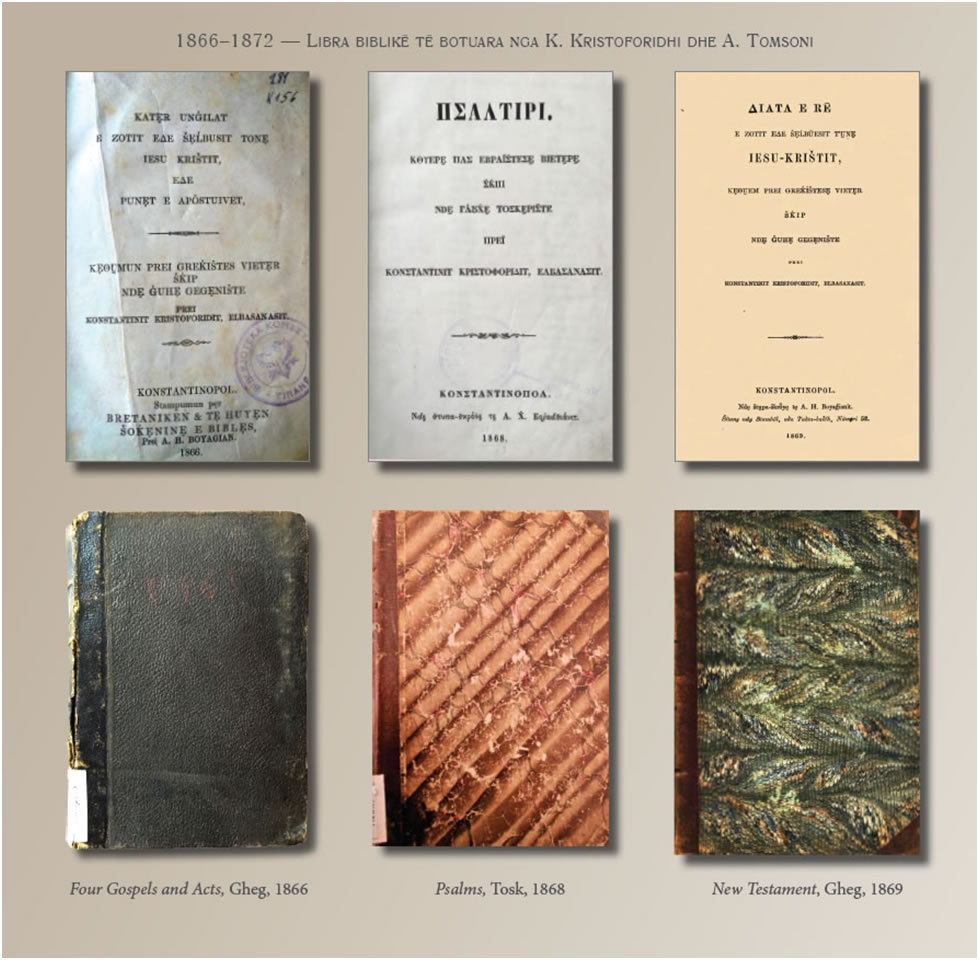 Books published in Albanian by Kristoforidhi and Thomspon between 1866-1872. Photo appears in “The Albanian Book and Protestant Enterprise: a 200 year cultural journey”. (2017)
Books published in Albanian by Kristoforidhi and Thomspon between 1866-1872. Photo appears in “The Albanian Book and Protestant Enterprise: a 200 year cultural journey”. (2017)
However the fruit of his labors with come to fruition in subsequent years, through the work and ministry of the Qiriazi family.
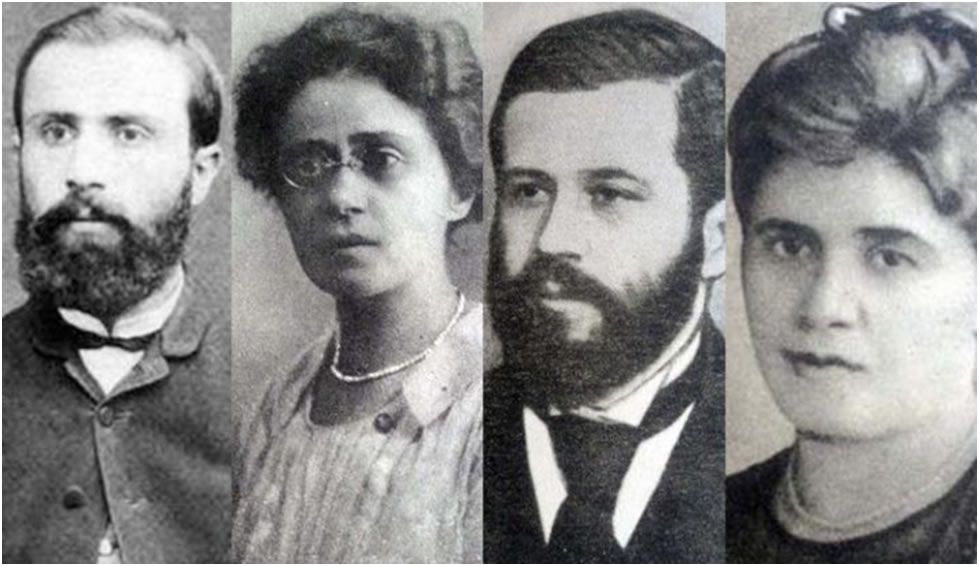 (The Qiriazi (Kyrias family), left to right: Gjerasim Qiriazi, Albanian evangelical preacher, Parashqevi Qiriazi, teacher and activist, Gjergj Qiriazi, teacher, author and activist, Sevasti Qiriazi, teacher, founder of the first Albanian school for girls, activist)
(The Qiriazi (Kyrias family), left to right: Gjerasim Qiriazi, Albanian evangelical preacher, Parashqevi Qiriazi, teacher and activist, Gjergj Qiriazi, teacher, author and activist, Sevasti Qiriazi, teacher, founder of the first Albanian school for girls, activist)
The American Board of missions established in 1810 began a work in the Ottoman Empire and in 1873 sent two American missionary families, the Jenneys and the Bairds to establish a missionary station in Manastir, an Albanian city in present day North Macedonia. They set up a church and a school, and they are credited with the conversion and discipleship of the first known native Albanian pastor in the 19th century, Gjerasi Qiriazi. He would go on to study in the American Theological Seminary in Samakov, Bulgaria. Later he came in contact with Alexander Thomson of the British Bible Society. In 1884 he would be employed by them as the primary responsible person for the Albanian work. Gjerasim moved back to Manastir and establish a mission there, opening a book depot and overseeing the work of the book distributors.
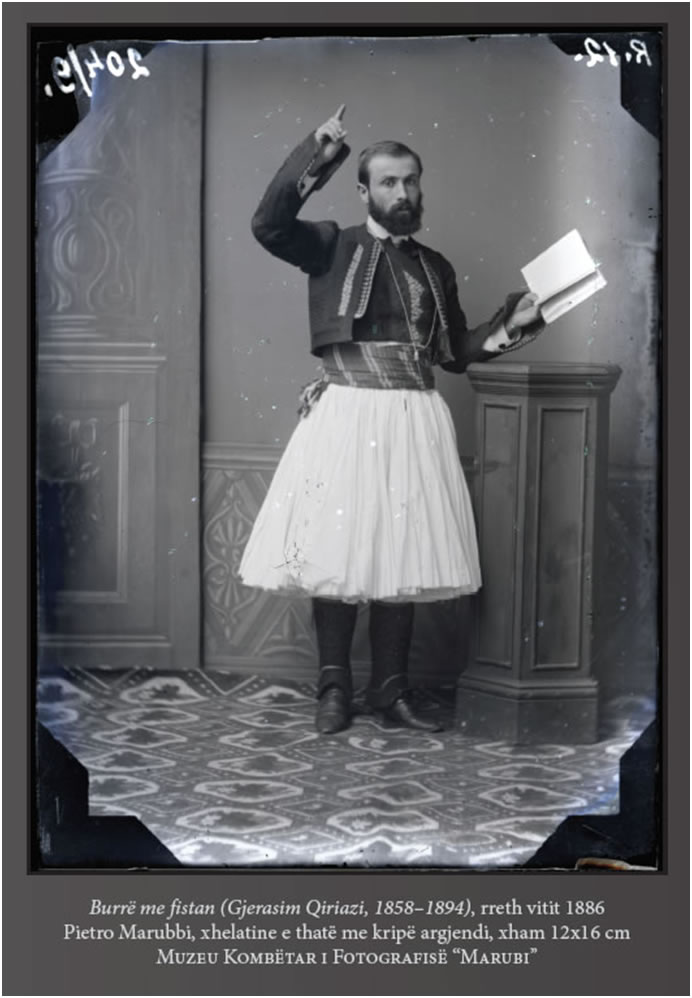 (Gjerasim Qiriazi in traditional Albanian costume
(Gjerasim Qiriazi in traditional Albanian costume
Gjerasim Qiriazi, (as seen above preaching from the pulpit wearing a traditional male costume of the Albanian South), was the director of the Albanian Evangelical Worship services, administrator of the Bible society depot, and supervisor of the Bible distributors. Under cooperation with Thomson, Gjerasim would revise and refine earlier publications of the Kristoforidhi printings and oversee the continuous printing of new materials.
The Albanian mission would set up an important work in Korca, which included the first Albanian school for girls set up by the remarkable Qiriazi sisters, (known as the teachers of the nation), a congregation of Bible believers, where Gjerasim preached as well as Gregor Cilka, a Moody Bible Seminary graduate. In 1892 they founded the Albanian Evangelical Fellowship, which revived in the 1990s and is the Union of the Albanian Evangelical Churches to this day.
But the most important educational contribution of the Qiriazi family was their role in the Manastiri Congress, a gathering of Albanian luminaries to determine a unified and standardized Albanian Alphabet. Albanians owe their first Alphabet, their first printed book, their first schools, their first dictionary to a handful of Bible believers, shining in the darkness of the dark ages with their resolute faith in God and a fervent zeal for the souls of their nation.
After the Congress of Manastir the work continued for the publishing of biblical texts with the new alphabet, ever hoping for help to conclude an entire translation, but every attempt for a new work was not successful, especially after the death of Gjerasim Qiriazi at 36 years old.
 Books of the Bible published in Albanian between 1909-1914. Photo appears in “The Albanian Book and Protestant Enterprise: a 200 year cultural journey”. (2017)
Books of the Bible published in Albanian between 1909-1914. Photo appears in “The Albanian Book and Protestant Enterprise: a 200 year cultural journey”. (2017)
Albania under Communism After many bloody wars and sacrifices, Albania gained independence from the Ottoman Empire in 1912, but became the ground of many new battles during the two world wars, and then fell behind the Iron Curtain from 1945-1991. During the communist dictatorship rule of Enver Hoxha, the country would experience an unprecedented event in modern history.
 (Enver Xhoxha, the communist dictator of Albania delivering a speech circa 1970s)
(Enver Xhoxha, the communist dictator of Albania delivering a speech circa 1970s)
On February 6, 1967 Hoxha intensified the war against religion with a fiery speech against “all religious ideology”, declaring “Religion is the opium of the people” – a quote adapted from the writing of communist philosopher Karl Marx. By 1976, Albania was declared to be the first atheist country in the world, legalizing a ban on religious belief via the constitution and imposing punishments for participating in religious ceremonies and possessing religious books. Article 37 of the constitution declared: “The state recognizes no religion and supports and develops atheistic propaganda to engage people in the materialistic scientific worldview.”
Article 55 meanwhile prohibited the establishment of any organization of a religious character. In total, more than 2,169 religious institutions were closed, buildings destroyed or sequestered by the state, and religious books of all faiths were burned and banned from circulation10.
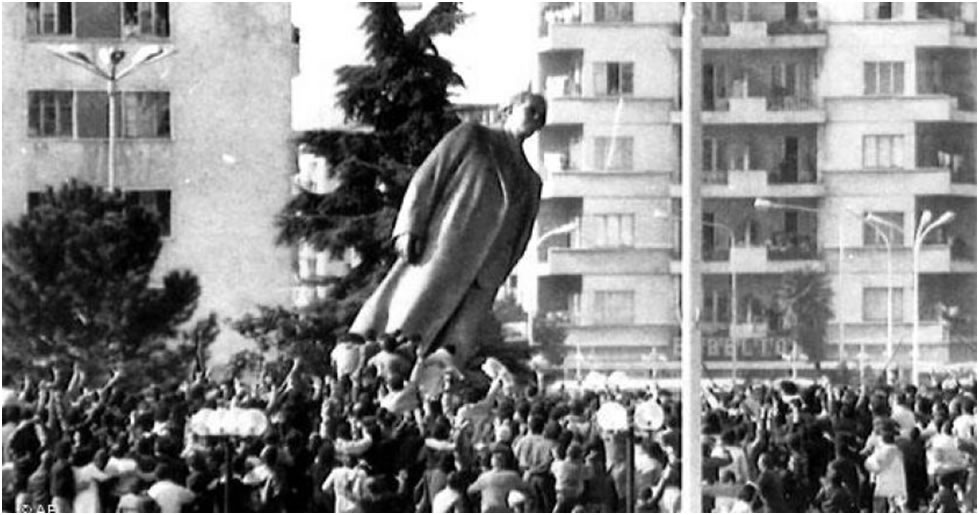 (the overthrow of Enver Hoxha’s monument in Tirana, March 1991, at the height of anti-communist popular protests)
(the overthrow of Enver Hoxha’s monument in Tirana, March 1991, at the height of anti-communist popular protests)
Present day After the fall of Communism in 1991, Albania still did not have a complete Bible. The Albanian Bible Society was established shortly after the fall of Communism and the first complete Bible in Albanian was published in 1994, containing the Old and New Testament. It was translated from the Italian text - Nuova Diodati Revisione 1991.
 The first complete (OT & NT) Bible in Albanian. Photo appears in “The Albanian Book and Protestant Enterprise: a 200 year cultural journey”. (2017)
The first complete (OT & NT) Bible in Albanian. Photo appears in “The Albanian Book and Protestant Enterprise: a 200 year cultural journey”. (2017)
This is the Bible widely used by the Evangelical and Protestant churches in Albania in the last 30 years. The translation was done under an immense time pressure, with the understanding that in time it would undergo refinement and revisions for accuracy both biblically and linguistically. The New Testament was revised in 2002 and the Old Testament in 2009. However, the subsequent work failed to improve on the existing translation and rather introduced new issues and problems.
From 1827-2009 all the Albanian Bible texts in wide use are from the Textus Receptus line. Last year a new translation based on the Nestle-Aland Greek text from the corrupt line of manuscripts has been concluded. In contains both Old and New Testaments and it is the work of three translators: a Catholic priest, an (Eastern) Orthodox priest, and a professing Protestant. It is called “the together” version and it is an ecumenical Bible.
Sadly, there's still not an accurate Bible translation in Albanian. Burdended about the state of the Bible in Albanian and as a result the state of many evangelical churches, the Lord put a burden on our hearts to undertake a new project to provide a faithful and accurate translation of the scriptures in Albanian.